Study on the Dynamic Relationship between Chinese Residents’ Individual Characteristics and Commercial Health Insurance Demand
Abstract
1. Introduction
2. Relevant Literature Review
3. Theoretical Analysis and Research Hypothesis
3.1. Dynamic Relationship between Residents’ Age Characteristics and Commercial Health Insurance Demand
3.2. Dynamic Relationship between Residents’ Household Registration Characteristics and Commercial Health Insurance Demand
3.3. Dynamic Relationship between Residents’ Gender Characteristics and Commercial Health Insurance Demand
3.4. Dynamic Relationship between Residents’ Education Characteristics and Commercial Health Insurance Demand
3.5. Dynamic Relationship between Residents’ Marriage Characteristics and Commercial Health Insurance Demand
4. Study Design
4.1. Variable Specifications
4.2. Data Introduction
4.3. Model Setting
4.3.1. Reasons for Using the SVAR Model
4.3.2. Introduction to SVAR Model
4.3.3. SVAR Model Expression
5. Empirical Analysis
5.1. Stationarity Test and Cointegration Test of Variable Data
5.2. Determination of the Optimal Lag Period of the Model
5.3. Define Constraint Matrix
5.4. Model Stability Test
5.5. Impulse Response Analysis
5.6. Variance Decomposition Analysis
6. Conclusions
- (1)
- The five representative variables of residents’ individual characteristics all have an impact on the demand for commercial health insurance, but the degree of importance is different. The importance, from high to low, is residents’ age characteristics, household registration characteristics, education characteristics, marriage characteristics and sex characteristics;
- (2)
- The age characteristics, household registration characteristics, education characteristics, marriage characteristics and gender characteristics of residents have time lag on the demand for commercial health insurance;
- (3)
- There is a long-term equilibrium relationship between the six variables, that is, some linear combination of the six variables is stable;
- (4)
- In terms of age characteristics of residents, there is a positive effect in the short term, and significantly inhibits the demand for commercial health insurance in the long term;
- (5)
- In terms of household registration characteristics, education characteristics and marriage characteristics, there is a positive effect on the whole, but a negative effect in a certain period;
- (6)
- In terms of gender characteristics of residents, there is a negative effect in the short term and a significant promotion of the demand for commercial health insurance in the long term.
7. Policy Enlightenments
- (1)
- Strengthen the research and development of commercial health insurance products to meet the health security needs of residents of different ages. The specific measures are as follows: Firstly, in terms of elderly residents, insurance companies should develop commercial health insurance products according to the physiological and psychological characteristics of the elderly residents, such as long-term care insurance, silver health insurance and serious disease insurance. Secondly, in terms of children and adolescents, insurance companies should actively promote children’s health insurance, harmonious and healthy children’s insurance, infant health insurance products, etc., in view of the fact that minors are the “heart of the family” and have their own unique characteristics;
- (2)
- Strive to improve the education level of residents and optimize the educational structure of the population. The specific measures are as follows: Firstly, strengthen the construction of rural basic education facilities, introduce high-level talents into rural areas, promote educational exchanges between rural and urban areas, and narrow the gap between urban and rural education resources. Secondly, increase the investment in educational resources, deepen the reform of the education system, increase the number of colleges and universities, and build a high-quality higher education personnel training system;
- (3)
- Actively promote the transformation of the rural population into urban residents and effectively improve the consumption level of residents. The specific measures are as follows: Firstly, speed up the urbanization process of the household registration population; improve the medical, serious disease, nursing disability and other health security systems; promote the development of urbanization; and improve the quality of urbanization. Secondly, promote employment by attracting investment, actively develop tertiary industry, increase residents’ disposable income, and optimize residents’ consumption structure;
- (4)
- Encourage early marriage and childbearing and advocate a happy and harmonious family. The specific measures are as follows: Firstly, in view of the current situation of aging and fewer children in China, improve relevant laws and regulations, actively publicize and implement the “open three-child” policy, guide young people of appropriate age to get married as early as possible, and encourage newlywed families to have more children so as to achieve a long-term balance of population age structure. Secondly, actively promote the construction of a harmonious family featuring “love between husband and wife, respect for the old and care for the young, and harmony among neighbors”, strive to improve the quality of life of women, and rely on women’s progress in civilization to drive the harmony of the family.
8. Research Prospects
Author Contributions
Funding
Institutional Review Board Statement
Informed Consent Statement
Data Availability Statement
Conflicts of Interest
Appendix A
| Year | Healthins | Age | Urban | Sex | Edu | Married |
|---|---|---|---|---|---|---|
| 1997 | 1.19 | 48.1 | 31.91 | 51.07 | 2.74 | 80.46 |
| 1998 | 1.98 | 47.9 | 33.35 | 51.25 | 2.79 | 80.67 |
| 1999 | 2.9 | 47.7 | 34.78 | 51.43 | 3.09 | 81.19 |
| 2000 | 5.17 | 42.6 | 36.22 | 51.63 | 3.61 | 81.2 |
| 2001 | 4.82 | 42 | 37.66 | 51.46 | 3.8 | 80.49 |
| 2002 | 9.53 | 42.2 | 39.09 | 51.47 | 4.71 | 80.5 |
| 2003 | 18.72 | 42 | 40.53 | 51.5 | 5.49 | 80.4 |
| 2004 | 19.99 | 41 | 41.76 | 51.52 | 5.77 | 80.46 |
| 2005 | 23.89 | 38.8 | 42.99 | 51.53 | 5.56 | 80.83 |
| 2006 | 28.68 | 38.3 | 44.34 | 51.52 | 6.22 | 80.61 |
| 2007 | 29.08 | 37.9 | 45.89 | 51.5 | 6.56 | 80.77 |
| 2008 | 44.09 | 37.4 | 46.99 | 51.47 | 6.7 | 81.05 |
| 2009 | 42.99 | 36.9 | 48.34 | 51.44 | 7.29 | 81.24 |
| 2010 | 50.52 | 34.2 | 49.95 | 51.27 | 8.93 | 79.16 |
| 2011 | 51.35 | 34.4 | 51.27 | 51.26 | 10.06 | 79.17 |
| 2012 | 63.72 | 34.9 | 52.57 | 51.25 | 10.59 | 79.59 |
| 2013 | 82.55 | 35.3 | 53.73 | 51.24 | 11.32 | 79.82 |
| 2014 | 116.02 | 36.2 | 54.77 | 51.23 | 11.53 | 80.31 |
| 2015 | 175.31 | 37 | 56.1 | 51.22 | 13.33 | 80.32 |
| 2016 | 292.3 | 37.9 | 57.35 | 51.21 | 12.94 | 81.09 |
| 2017 | 315.79 | 39.2 | 58.52 | 51.17 | 13.87 | 81.41 |
| 2018 | 390.55 | 40.4 | 59.58 | 51.13 | 14.01 | 81.83 |
| 2019 | 504.71 | 41.5 | 60.6 | 51.09 | 14.58 | 81.98 |
| 2020 | 578.82 | 63.89 | 51.24 | 15.47 | 82.12 |
| Lag | Chi-Square Value | p Value | Result |
|---|---|---|---|
| 1 | 29.1556 | 0.78357 | Accept H0 |
| 2 | 39.0498 | 0.33437 | Accept H0 |
| Equation | Chi-Square Value | p Value | Result |
|---|---|---|---|
| lnhealthins | 0.993 | 0.60865 | Accept H0 |
| age | 0.435 | 0.80438 | Accept H0 |
| urban | 2.508 | 0.28541 | Accept H0 |
| sex | 0.574 | 0.75059 | Accept H0 |
| edu | 1.527 | 0.46610 | Accept H0 |
| married | 1.228 | 0.54119 | Accept H0 |
| ALL | 7.265 | 0.83965 | Accept H0 |
| Matrix A: Element | Result | Matrix B: Element | Result |
|---|---|---|---|
| /a_1_1 | 1 (constrained) | /b_1_1 | 0.0953318 *** (6.48) |
| /a_2_1 | −0.4123113(−0.26) | /b_2_1 | 0 (constrained) |
| /a_3_1 | −0.127424(−0.81) | /b_3_1 | 0 (constrained) |
| /a_4_1 | −0.12607 * (−1.88) | /b_4_1 | 0 (constrained) |
| /a_5_1 | −0.7909315 * (−1.78) | /b_5_1 | 0 (constrained) |
| /a_6_1 | 0.2957847(1.23) | /b_6_1 | 0 (constrained) |
| /a_1_2 | 0 (constrained) | /b_1_2 | 0 (constrained) |
| /a_2_2 | 1 (constrained) | /b_2_2 | 0.6960162 *** (6.48) |
| /a_3_2 | 0.0792621 *** (3.69) | /b_3_2 | 0 (constrained) |
| /a_4_2 | 0.0084896(0.73) | /b_4_2 | 0 (constrained) |
| /a_5_2 | 0.0381074(0.53) | /b_5_2 | 0 (constrained) |
| /a_6_2 | −0.2390485 *** (−6.53) | /b_6_2 | 0 (constrained) |
| /a_1_3 | 0 (constrained) | /b_1_3 | 0 (constrained) |
| /a_2_3 | 0 (constrained) | /b_2_3 | 0 (constrained) |
| /a_3_3 | 1 (constrained) | /b_3_3 | 0.0684888 *** (6.48) |
| /a_4_3 | 0.0588696(0.64) | /b_4_3 | 0 (constrained) |
| /a_5_3 | −2.749896 *** (−4.85) | /b_5_3 | 0 (constrained) |
| /a_6_3 | −0.6953342 * (−1.67) | /b_6_3 | 0 (constrained) |
| /a_1_4 | 0 (constrained) | /b_1_4 | 0 (constrained) |
| /a_2_4 | 0 (constrained) | /b_2_4 | 0 (constrained) |
| /a_3_4 | 0 (constrained) | /b_3_4 | 0 (constrained) |
| /a_4_4 | 1 (constrained) | /b_4_4 | 0.0287862 *** (6.48) |
| /a_5_4 | 4.959975 *** (3.71) | /b_5_4 | 0 (constrained) |
| /a_6_4 | −5.808754 *** (−6.68) | /b_6_4 | 0 (constrained) |
| /a_1_5 | 0 (constrained) | /b_1_5 | 0 (constrained) |
| /a_2_5 | 0 (constrained) | /b_2_5 | 0 (constrained) |
| /a_3_5 | 0 (constrained) | /b_3_5 | 0 (constrained) |
| /a_4_5 | 0 (constrained) | /b_4_5 | 0 (constrained) |
| /a_5_5 | 1 (constrained) | /b_5_5 | 0.176263 *** (6.48) |
| /a_6_5 | 0.607572 *** (5.51) | /b_6_5 | 0 (constrained) |
| /a_1_6 | 0 (constrained) | /b_1_6 | 0 (constrained) |
| /a_2_6 | 0 (constrained) | /b_2_6 | 0 (constrained) |
| /a_3_6 | 0 (constrained) | /b_3_6 | 0 (constrained) |
| /a_4_6 | 0 (constrained) | /b_4_6 | 0 (constrained) |
| /a_5_6 | 0 (constrained) | /b_5_6 | 0 (constrained) |
| /a_6_6 | 1 (constrained) | /b_6_6 | 0.0891474 *** (6.48) |
| Model parameter identification results | Exactly identification | ||
| Sample | 1999–2019 | ||
| Obs | 21 | ||
| Log likelihood | 96.2079 | ||
References
- Xu, B.C.; Li, X.J.; Gao, M.Y. Influence of Commercial Insurance Purchase on the Health Status of Chinese Residents. Front. Public Health 2021, 9, 752530. [Google Scholar] [CrossRef]
- Xu, B.C.; Xu, X.N.; Zhao, J.C.; Zhang, M. Influence of Internet Use on Commercial Health Insurance of Chinese Residents. Front. Public Health 2022, 10, 907124. [Google Scholar] [CrossRef] [PubMed]
- Tian, L.; Dong, H.S. Family Life Cycle, Asset Portfolio, and Commercial Health Insurance Demand in China. Int. J. Environ. Res. Public Health 2022, 19, 16795. [Google Scholar] [CrossRef]
- Yang, P.; Chen, Z.P. Optimal Time-consistent Social Health Insurance and Private Health Insurance Strategy under a New Health Insurance Framework. Appl. Stoch. Model. Bus. Ind. 2022, 38, 726–743. [Google Scholar] [CrossRef]
- Li, C.; Wang, S.F.; Liu, X.H.; Wang, L. Does the Development of the Insurance Industry Promote the Purchase of Rural Commercial Health Insurance? Front. Public Health 2021, 9, 695121. [Google Scholar] [CrossRef] [PubMed]
- Shusha, A.A. Does Financial Literacy Moderate the Relationship among Demographic Characteristics and Financial Risk Tolerance? Evidence from Egypt. Australas. Account. Bus. Financ. J. 2017, 11, 67–86. [Google Scholar] [CrossRef]
- Hopkins, S.; Kidd, M.P. The Determinants of the Demand for Private Health Insurance under Medicare. Appl. Econ. 1996, 28, 1623–1632. [Google Scholar] [CrossRef]
- Saver, B.G.; Doescher, M.P. To Buy, or Not to Buy: Factors Associated with the Purchase of Nongroup, Private Health Insurance. Med. Care 2000, 38, 141–151. [Google Scholar] [CrossRef]
- Bundorf, M.K. Employee Demand for Health Insurance and Employer Health Plan Choices. J. Health Econ. 2002, 21, 65–88. [Google Scholar] [CrossRef]
- Asgary, A.; Willis, K.; Taghvaei, A.A.; Rafeian, M. Estimating Rural Households’ Willingness to Pay for Health Insurance. Eur. J. Health Econ. 2004, 5, 209–215. [Google Scholar] [CrossRef]
- Wang, H.H.; Rosenman, R. Perceived Need and Actual Demand for Health Insurance among Rural Chinese Residents. China Econ. Rev. 2007, 18, 373–388. [Google Scholar] [CrossRef]
- Khwaja, A. Estimating Willingness to Pay for Medicare Using a Dynamic Life-cycle Model of Demand for Health Insurance. J. Econom. 2010, 156, 130–147. [Google Scholar] [CrossRef]
- Lee, Y.W. Asymmetric Information and the Demand for Private Health Insurance in Korea. Econ. Lett. 2012, 116, 284–287. [Google Scholar] [CrossRef]
- Oraro, T.; Ngube, N.; Atohmbom, G.Y.; Srivastava, S.; Wyss, K. The Influence of Gender and Household Headship on Voluntary Health Insurance: The Case of North-West Cameroon. Health Policy Plan. 2018, 33, 163–170. [Google Scholar] [CrossRef]
- Wang, Q.; Zhou, Y.; Ding, X.R.; Ying, X.H. Demand for Long-Term Care Insurance in China. Int. J. Environ. Res. Public Health 2018, 15, 6. [Google Scholar] [CrossRef] [PubMed]
- Kapur, K. Private Health Insurance in Ireland: Trends and Determinants. Econ. Soc. Rev. 2020, 51, 63–92. [Google Scholar]
- Doiron, D.; Kettlewell, N. Family Formation and the Demand for Health Insurance. Health Econ. 2020, 29, 523–533. [Google Scholar] [CrossRef]
- Kattih, N.; Mixon, F.G. Employee Choice and the Demand for Health Insurance Coverage: Evidence from Random Coefficients Models. BE J. Econ. Anal. Policy 2020, 20, 20190153. [Google Scholar] [CrossRef]
- Zhong, Q.; Zhang, H.; Sun, X.K. Exposure to Abnormally Hot Temperature and the Demand for Commercial Health Insurance. Front. Public Health 2022, 10, 842665. [Google Scholar] [CrossRef]
- Call, K.T.; Fertig, A.R.; Pascale, J. Factors Associated with Accurate Reporting of Public and Private Health Insurance Type. Health Serv. Res. 2022, 57, 930–943. [Google Scholar] [CrossRef]
- Gao, L.F.; Guan, J.; Wang, G.J. Does Media-based Health Risk Communication Affect Commercial Health Insurance Demand? Evidence from China. Appl. Econ. 2022, 54, 2122–2134. [Google Scholar] [CrossRef]
- Jia, P.; Yan, J.S. Effects of Haze Pollution and Institutional Environment on Demand for Commercial Health Insurance. Front. Psychol. 2022, 13, 1002470. [Google Scholar] [CrossRef]
- Survey Data—Official Website of the China Banking and Insurance Regulatory Commission (CBIRC). Available online: http://www.cbirc.gov.cn/cn/view/pages/tongjishuju/tongjishuju.html (accessed on 16 June 2022).
- Survey Data——China Statistical Yearbook. Available online: https://data.cnki.net/yearBook/single?nav%E7%BB%9F%E8%%20AE%A1%E5%B9%B4%E9%89%B4&id=N2022110021 (accessed on 16 June 2022).
- Hao, Y.Y. The Relationship between LNG price, LNG Revenue, Non-LNG Revenue and Government Spending in China: An Empirical Analysis Based on the ARDL and SVAR Model. Energy & Environment. 2021. Available online: https://ersp.lib.whu.edu.cn/s/org/doi/G.https/10.1177/0958305X211053621 (accessed on 5 December 2022).
- Cheng, H.F.; Hong, C.X.; Li, H.Y.; Zhang, Y. Does the China-U.S. Trade Imbalance Stem from Difference in the Comparative Advantages of Service Trade? Empirical Analysis Based on SVAR Model. Emerg. Mark. Financ. Trade 2022. [Google Scholar] [CrossRef]
- Aleem, A.; Lahiani, A. Estimation and Evaluation of Core Inflation Measures. Appl. Econ. 2011, 43, 3619–3629. [Google Scholar] [CrossRef]
- Liu, D.H.; Meng, L.J.; Wang, Y.D. Oil Price Shocks and Chinese Economy Revisited: New Evidence from SVAR Model with Sign Restrictions. Int. Rev. Econ. Financ. 2020, 69, 20–32. [Google Scholar] [CrossRef]
- Deng, C.; Liang, C.C.; Hong, Y.; Jiang, Y.H. CCTV News’ Asymmetric Impact on the Chinese Stock Market during COVID-19: A Combination Analysis Based on the SVAR and NARDL Models. Emerg. Mark. Financ. Trade 2022. [Google Scholar] [CrossRef]
- Zhang, Y.C. The Role of Monetary Shocks and Real Shocks on the Current Account, the Terms of Trade and the Real Exchange Rate Dynamics: A SVAR Analysis. Appl. Econ. 2009, 41, 2047–2063. [Google Scholar] [CrossRef]
- Mukhtarov, S.; Humbatova, S.; Mammadli, M.; Hajiyev, N.G.O. The Impact of Oil Price Shocks on National Income: Evidence from Azerbaijan. Energies 2021, 14, 1695. [Google Scholar] [CrossRef]
- Zhang, Q.D.; Chen, R.D. Financial Development and Income Inequality in China: An Application of SVAR Approach. Procedia Comput. Sci. 2015, 55, 774–781. [Google Scholar] [CrossRef]
- Fragetta, M.; Melina, G. The Effects of Fiscal Policy Shocks in SVAR Models: A Graphical Modelling Approach. Scott. J. Political Econ. 2011, 58, 537–566. [Google Scholar] [CrossRef]
- Chen, Q. Advanced Econometrics and Stata Applications, 2nd ed.; Higher Education Press: Beijing, China, 2014. (In Chinese) [Google Scholar]
- Yang, Y.F.; Zhang, S.; Zhang, N.N.; Wen, Z.H.; Zhang, Q.H.; Xu, M.; Zhang, Y.F.; Niu, M.C. The Dynamic Relationship between China’s Economic Cycle, Government Debt, and Economic Policy. Sustainability 2022, 14, 1029. [Google Scholar] [CrossRef]
- Afonso, A.; Leal, F.S. Fiscal Multipliers in the Eurozone: An SVAR Analysis. Appl. Econ. 2019, 51, 5577–5593. [Google Scholar] [CrossRef]
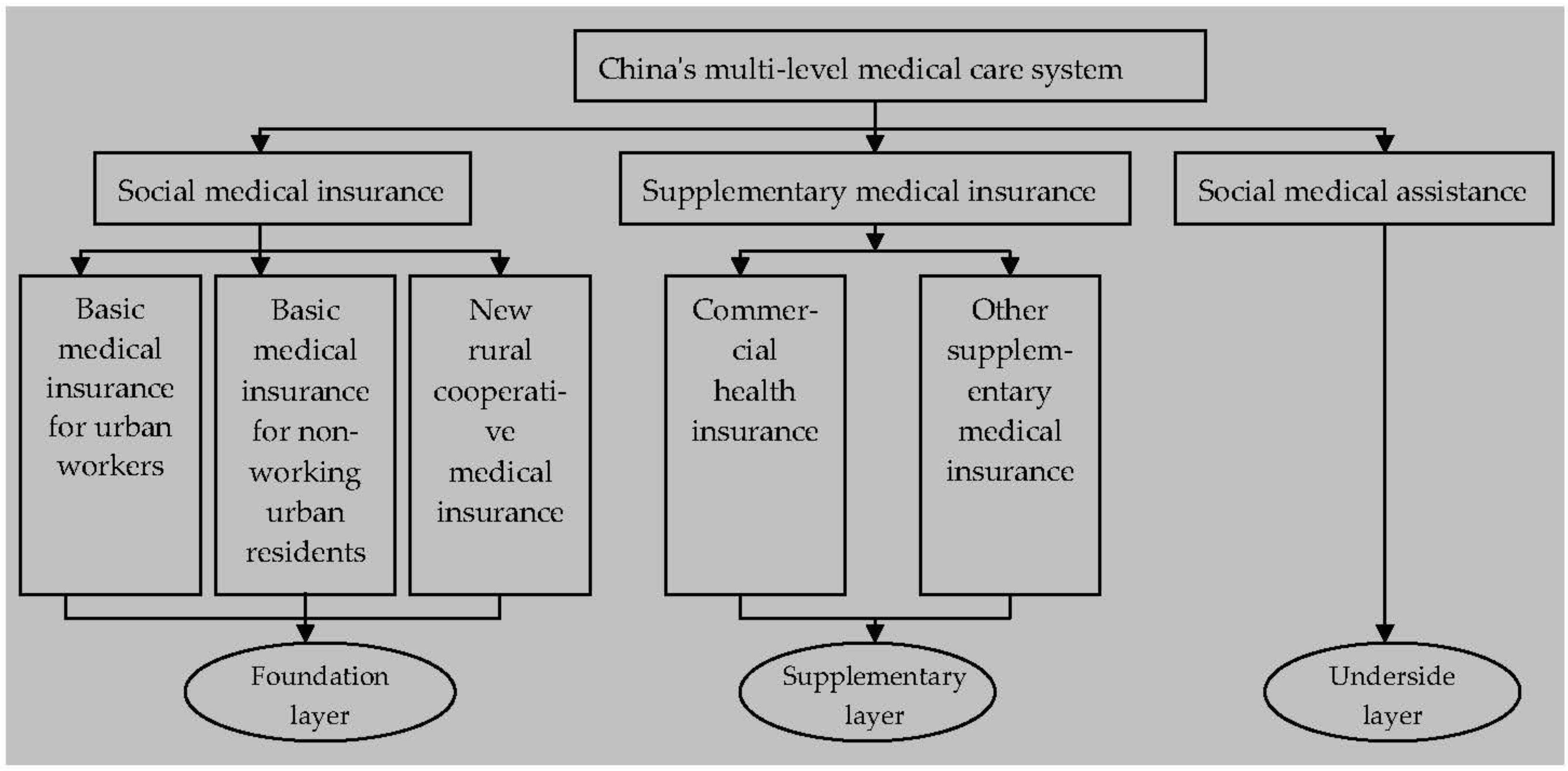
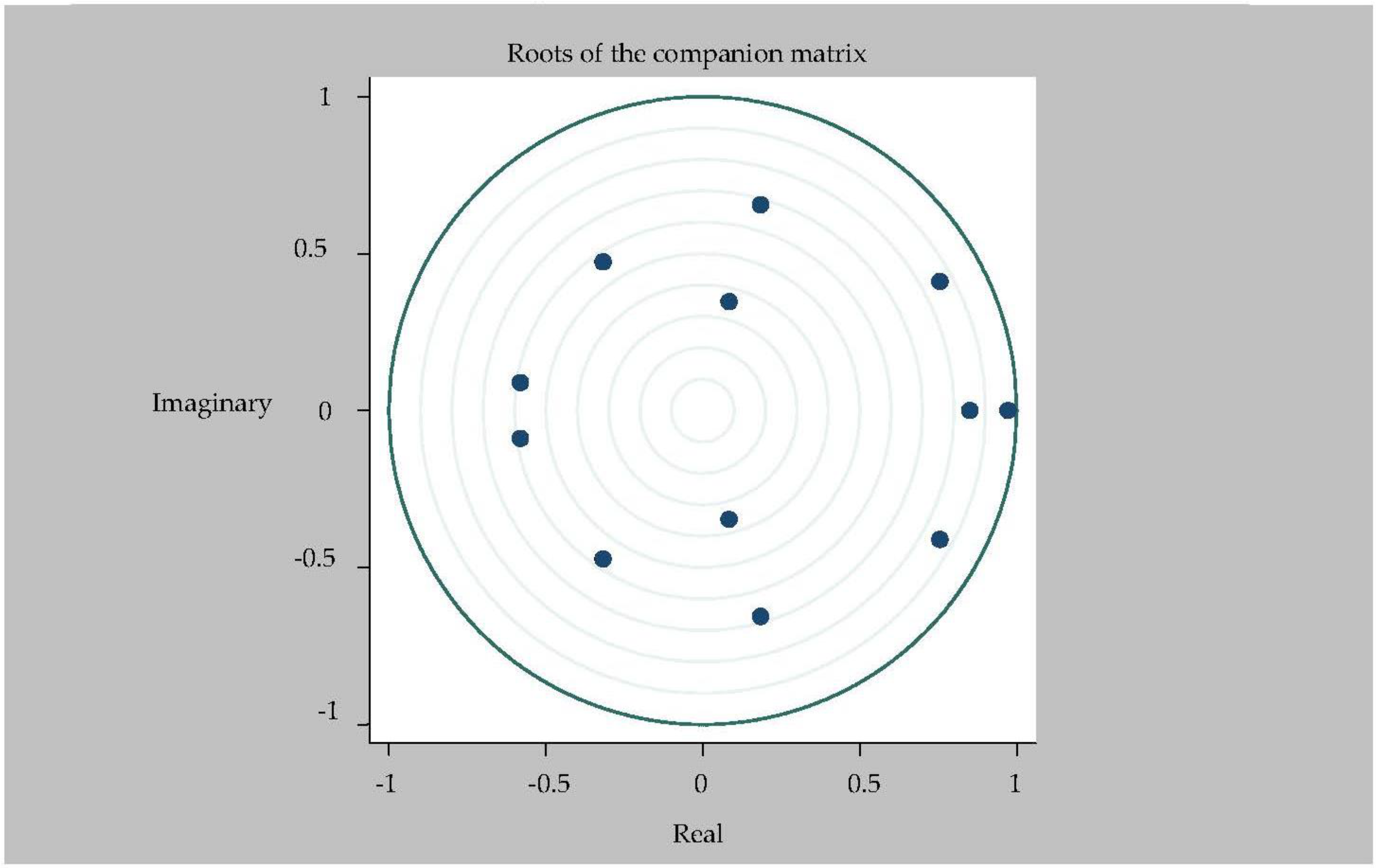

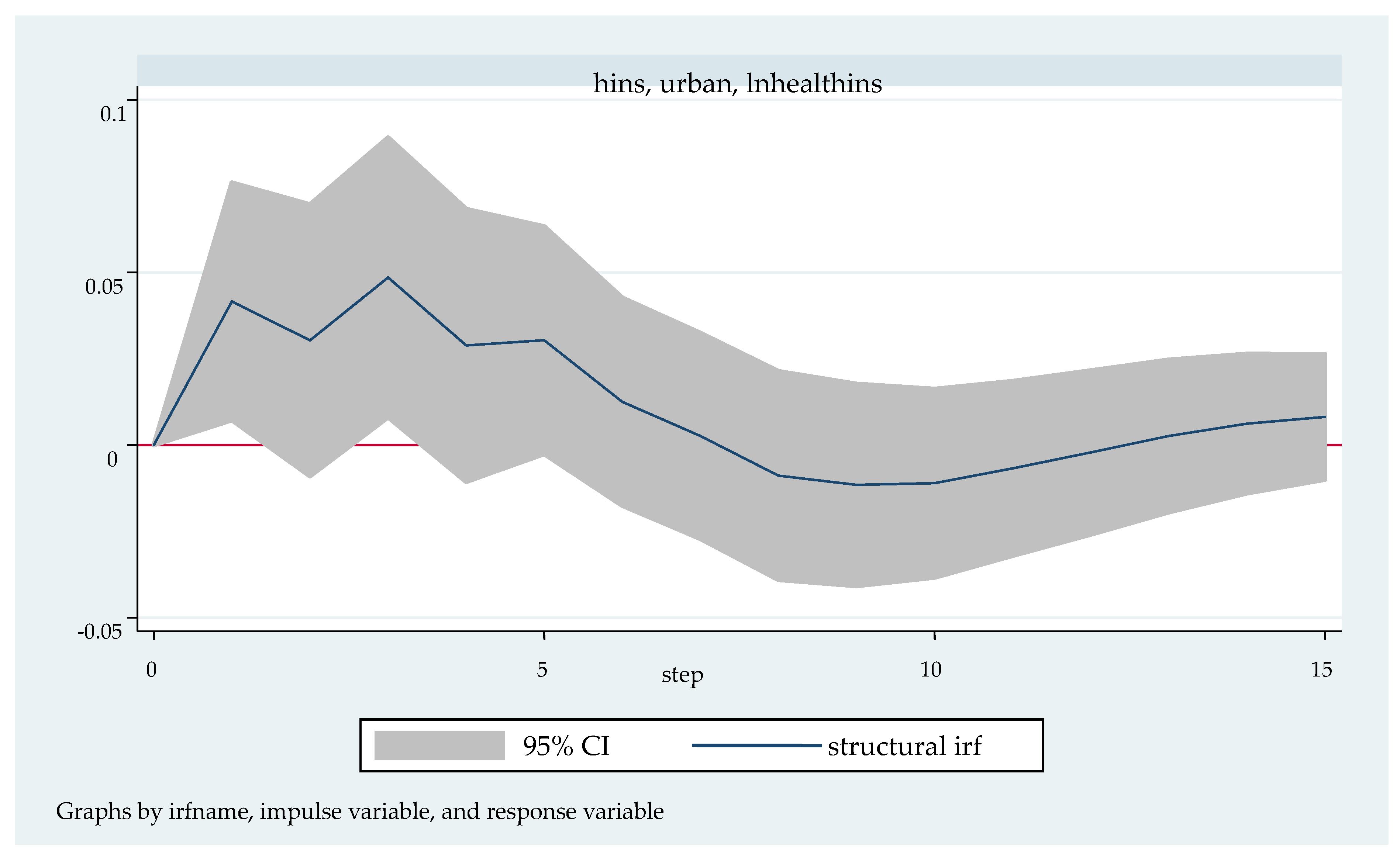
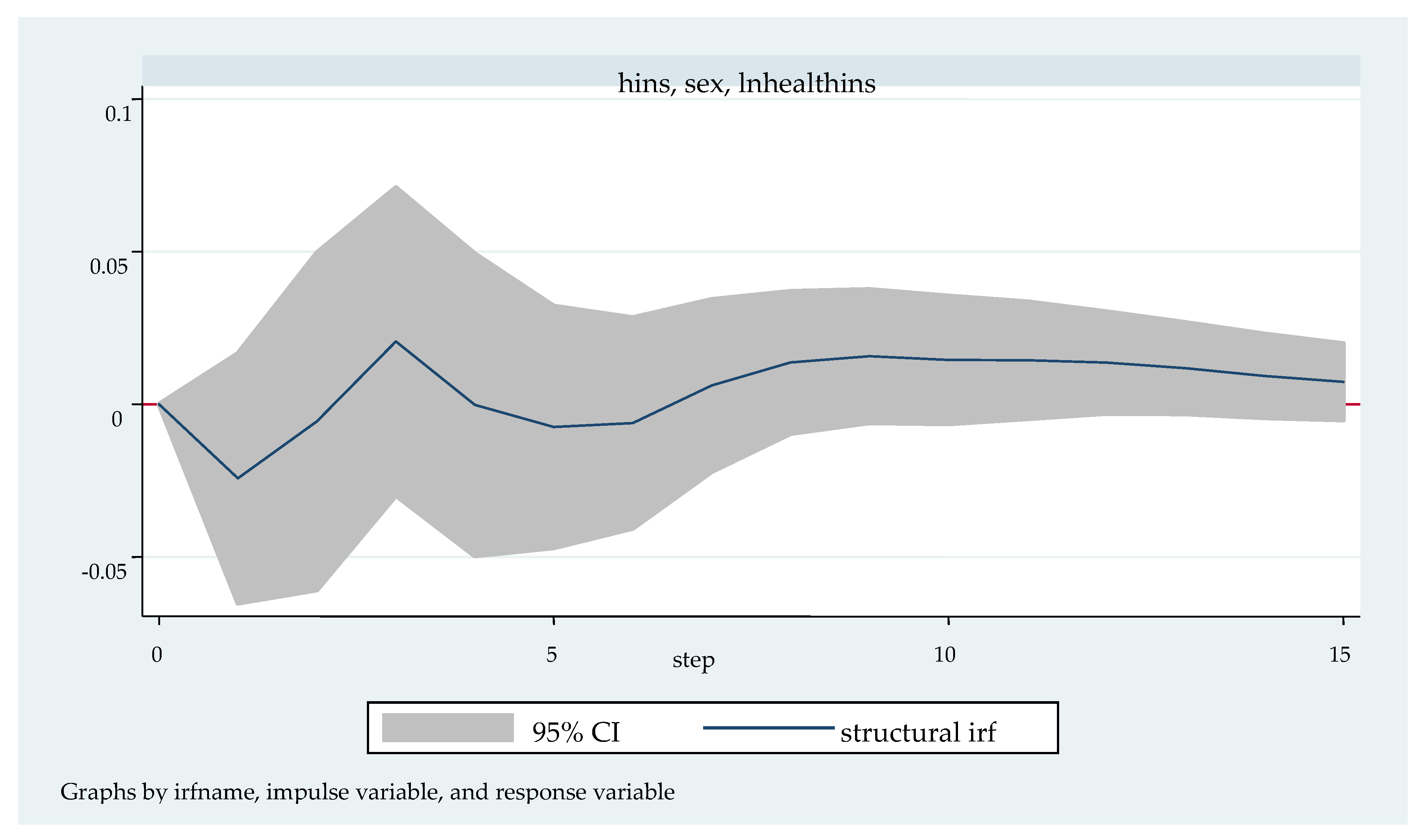
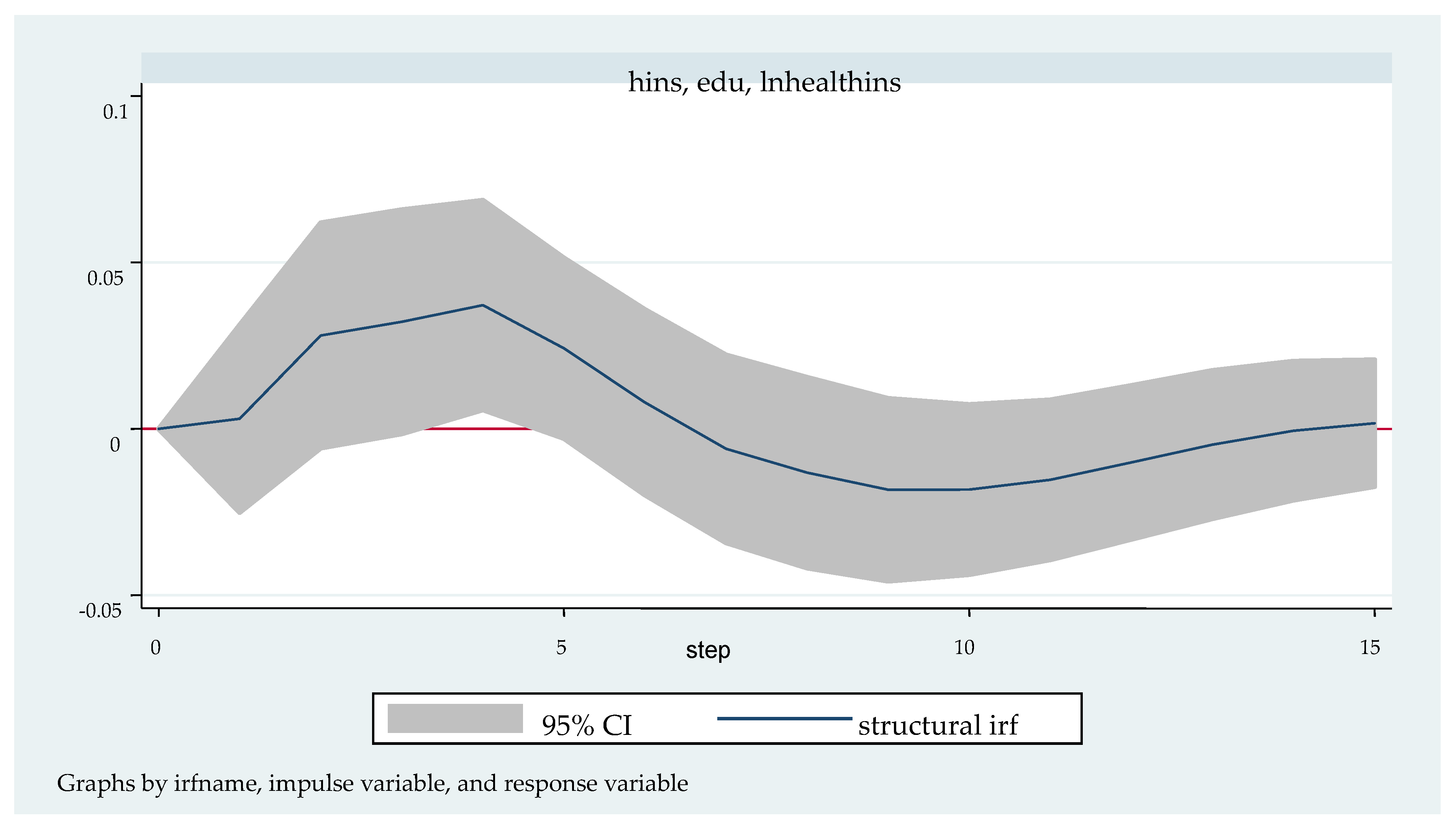

| Name of Variable | Symbol of Variable | Explanation of Variables |
|---|---|---|
| Health insurance demand (CNY/person) | healthins | Health insurance density, namely, per capita health insurance premium income of residents |
| Age characteristics (%) | age | Total dependency population ratio, namely, the proportion of people aged 0–14 and over 64 in the total population of the country aged 15–64 |
| Household registration characteristics (%) | urban | Urban population ratio, namely, the proportion of urban population in the total population of the country |
| Gender characteristics (%) | sex | Male population ratio, namely, the proportion of men in the total population of the country |
| Education characteristics (%) | edu | Higher education population ratio, namely, the proportion of the population with associate degree or above in the total population of the country aged 6 and above |
| Marriage characteristics (%) | married | Married population ratio, namely, the proportion of married people in the total population of the country aged 15 and above |
| Variable | ADF Value | 10% Critical Value | p Value | Result |
|---|---|---|---|---|
| age | −2.213 | −2.630 | 0.2015 | Unstable |
| urban | 0.430 | −2.630 | 0.9826 | Unstable |
| sex | −1.891 | −2.630 | 0.3365 | Unstable |
| edu | 0.671 | −2.630 | 0.9892 | Unstable |
| married | −1.252 | −2.630 | 0.6508 | Unstable |
| lnhealthins | −1.698 | −2.630 | 0.4319 | Unstable |
| D.age | −3.147 | −2.630 | 0.0232 ** | Stable |
| D.urban | −2.767 | −2.630 | 0.0632 * | Stable |
| D.sex | −3.633 | −2.630 | 0.0052 *** | Stable |
| D.edu | −5.668 | −2.630 | 0.0000 *** | Stable |
| D.married | −4.300 | −2.630 | 0.0004 *** | Stable |
| D.lnhealthins | −4.765 | −2.630 | 0.0001 *** | Stable |
| H0: Number of Co-Integrated Ranks | Eigenvalue | Statistic Value of Trace Test | 5% Critical Value | Result |
|---|---|---|---|---|
| 0 | 131.3985 | 94.15 | Reject H0 | |
| 1 | 0.92878 | 73.2736 | 68.52 | Reject H0 |
| 2 | 0.74086 | 43.5648 * | 47.21 | Accept H0 |
| Number of Lag Periods | FPE | AIC | HQIC | SBIC |
|---|---|---|---|---|
| 0 | 0.000106 | 7.87148 | 7.92196 | 8.16973 |
| 1 | 1.7 × 10−9 | −3.38247 | −3.02915 | −1.29477 |
| 2 | 2.8 × 10−10 * | −6.8186 | −6.16243 | −2.94143 |
| 3 | −315.126 | −314.167 | −309.46 | |
| 4 | −329.092 | −328.133 | −323.426 |
| Step | (1) | (2) | (3) | (4) | (5) |
|---|---|---|---|---|---|
| Age | Urban | Sex | Edu | Married | |
| 0 | 0 | 0 | 0 | 0 | 0 |
| 1 | 0 | 0 | 0 | 0 | 0 |
| 2 | 0.278797 | 0.086143 | 0.029317 | 0.000456 | 0.025807 |
| 3 | 0.227932 | 0.107755 | 0.025223 | 0.032355 | 0.03672 |
| 4 | 0.208833 | 0.165843 | 0.034603 | 0.060683 | 0.055686 |
| 5 | 0.194875 | 0.175836 | 0.031463 | 0.096849 | 0.067212 |
| 6 | 0.212659 | 0.185613 | 0.030199 | 0.104409 | 0.063053 |
| 7 | 0.231472 | 0.180492 | 0.029677 | 0.100874 | 0.060635 |
| 8 | 0.239762 | 0.174603 | 0.029635 | 0.098405 | 0.058615 |
| 9 | 0.239132 | 0.172279 | 0.033544 | 0.100278 | 0.057568 |
| 10 | 0.235033 | 0.172138 | 0.038908 | 0.10642 | 0.056445 |
| 11 | 0.231355 | 0.172286 | 0.043307 | 0.112612 | 0.055611 |
| 12 | 0.228417 | 0.170845 | 0.047553 | 0.116473 | 0.055447 |
| 13 | 0.226213 | 0.168889 | 0.051307 | 0.117422 | 0.055408 |
| 14 | 0.224372 | 0.167529 | 0.054052 | 0.116887 | 0.055311 |
| 15 | 0.222913 | 0.167302 | 0.055671 | 0.116131 | 0.055125 |
Disclaimer/Publisher’s Note: The statements, opinions and data contained in all publications are solely those of the individual author(s) and contributor(s) and not of MDPI and/or the editor(s). MDPI and/or the editor(s) disclaim responsibility for any injury to people or property resulting from any ideas, methods, instructions or products referred to in the content. |
© 2023 by the authors. Licensee MDPI, Basel, Switzerland. This article is an open access article distributed under the terms and conditions of the Creative Commons Attribution (CC BY) license (https://creativecommons.org/licenses/by/4.0/).
Share and Cite
Tian, L.; Dong, H. Study on the Dynamic Relationship between Chinese Residents’ Individual Characteristics and Commercial Health Insurance Demand. Int. J. Environ. Res. Public Health 2023, 20, 4797. https://doi.org/10.3390/ijerph20064797
Tian L, Dong H. Study on the Dynamic Relationship between Chinese Residents’ Individual Characteristics and Commercial Health Insurance Demand. International Journal of Environmental Research and Public Health. 2023; 20(6):4797. https://doi.org/10.3390/ijerph20064797
Chicago/Turabian StyleTian, Ling, and Haisong Dong. 2023. "Study on the Dynamic Relationship between Chinese Residents’ Individual Characteristics and Commercial Health Insurance Demand" International Journal of Environmental Research and Public Health 20, no. 6: 4797. https://doi.org/10.3390/ijerph20064797
APA StyleTian, L., & Dong, H. (2023). Study on the Dynamic Relationship between Chinese Residents’ Individual Characteristics and Commercial Health Insurance Demand. International Journal of Environmental Research and Public Health, 20(6), 4797. https://doi.org/10.3390/ijerph20064797








